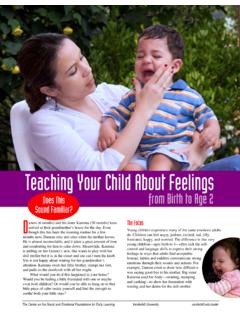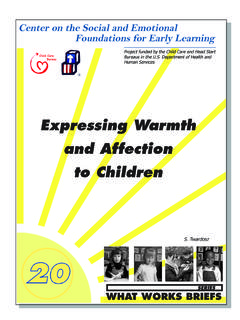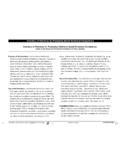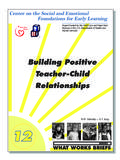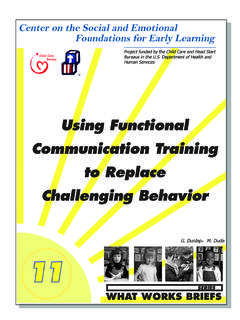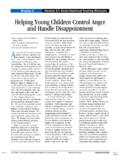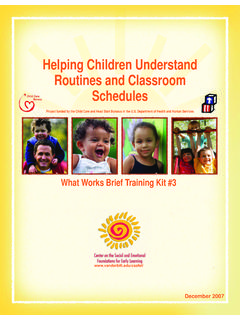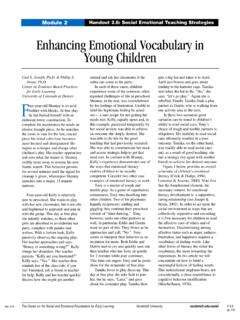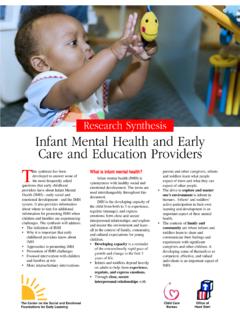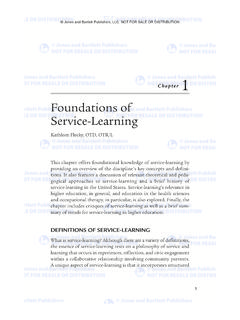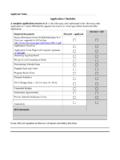Transcription of Helping Children Make Transitions between Activities
1 Project funded by the Child Care and Head Start Bureaus in the Department of Health and Human ServicesHelping Children Make Transitions between ActivitiesWhat Works Brief Training Kit #4 January 2008 What Works Brief Training Kits were developed to help in-service and pre-ser-vice providers conduct staff development Activities . Each Kit is based on one What Work Brief and contains the following items: presenter s PowerPoint note pages, participant handouts, activity ideas, pre-training survey, demographic form, training evaluation, and training certificate. The What Works Brief Training Kits are grounded in the Pyramid model depicted below which provides a framework for describing the four interrelated levels of prac-tice that address the social and emotional development of all Children . The Pyramid is designed to guide practitioners in understanding the importance of Children s social emotional competence in terms of school readiness and the prevention of challeng-ing behavior.
2 This What Works Brief Training Kit relates to the High Quality Environ-ments level of the Pyramid. We welcome your feedback as you provide professional development Activities with these materials. Special thanks to the Meginnis Endowment at UIUC for funding to help support this effort and to the following individuals who developed the What Works Brief Training Kits materials: Micki Ostrosky, Hedda Meadan, Greg Cheatham, Monique Mills, Sallee Beneke, Nancy Gaumer, Amy Hayden, Elenor Rentschler, and Angel Notes:Presenter should be familiar with the content in What Works Brief #4 and Module 1 Section VII on Schedules, Routines and Transitions (available at ). Welcome participants. Take care of any logistics ( , length of time for session, break, handouts, etc.).Consider using the What Works Brief # 4 handout as a supplemental out pre-training survey for all participants to complete and turn in, if you present the workshop: Remind participants to take the culture and background of Children into consideration and to work hand-in-hand with parents when they select target behaviors, since some behaviors may be part of the child s Training Kit #4 Helping Children Make Transitions between ActivitiesPresenter PowerPointPresenter NotesActivity 1 Pair-Think-SharePair with a partnerRead a scenarioThink about whyShare your thoughts Speaker Notes:Assign partners.
3 Have half the group read one scenario and half read the other scenario. Pairs should think of reasons why the child in the vignette might be having thoughts with the larger group by having one person read aloud a vignette then all who worked on that vignette share their , focusing on the other vignette. Activity 1 What Is the Problem?MichelleMichelle is a 3-year-old girl. She enjoys playing in the kitchen center and interacting with friends. When the teacher announces that it is time to clean up and sit on the carpet for group time, Michelle gets very upset. She throws toys and pushes other Children . When the teacher comes near her, Michelle starts screaming and saying that she is not finished playing. Speaker Notes: Possible reasons for Michelle s behavior that the group might come up with:The time is too short and Michelle barely gets into her play when it is time to clean upShe needs more warnings to anticipate cleanup time She does not like group time (it might be too long, too difficult, etc.)
4 She does not understand what it means to clean up how and where to put the toys away Activity 1 What Is the Problem?JimJim, a 4-year-old, is a new preschool student. He and the other preschoolers in his classroom are playing on the playground. When Miss Johns calls them to go inside, they all gather next to the entrance door. Jim stays in the sandbox. When Miss Johns approaches him and asks him to come with her, he startscrying and screaming, then drops to Notes:Possible reasons for Jim s behavior that the group might come up with:Jim is new and does not know the schedule The time is too short and Jim barely gets into playing in the sandbox when it is time to clean upJim needs more warnings to anticipate cleanup time Jim does not like the activity that follows outdoor recess time Jim does not know why Miss Johns wants him to come with her and assumes he has done something wrong TransitionTransition refers to a change Types of Transitions : Transitions between Activities Transitions between multiple settings Transitions between programs We will focus on transition between Activities .
5 Speaker Notes:Define refers to a change ( , who provides services , what Activities are available).There are 3 main types of Transitions : Transitions between Activities within a given setting ( , snack to playground; outdoor recess to large group). Transitions between multiple settings on the same day ( , preschool to after-school child-care program; Head Start program to child care). Transitions between programs ( , birth-three programs to preschool, preschool to elementary school). We will focus on transition between Activities . Why Is It Important to Address Transitions between Activities ? Transitions take time Children often spend a lot of time waiting Transitions can be stressful and frustrating Skills such as cleaning up may reduce transition times and may lead to more time for Children to be engaged in Activities When Children are taught what they should be doing, we are less likely to see problem behaviorsMany preschool teachers consider Children s ability to independently make Transitions a key skillSpeaker Notes: Transitions take a great deal of time During transition time, Children often spend much time waiting ( , wait until everyone has finished snack, wait for buses)Some Children (and adults) have stressful and frustrating experiences during Transitions between Activities ( , Children arguing over who took out what toys and should put them away.)
6 Children not knowing where to put certain toys when they are done with them)Skills such as cleaning up toys and lining up may reduce transition times and may lead to more time for Children to become engaged in learning Activities As Children become independent and are taught what they should be doing, we are less likely to see problem behaviors. Many preschool teachers and other caregivers consider Children s ability to ndependently make Transitions between Activities one of the essential skills needed in group contexts such as kindergarten and preschool. Activity 2 Identify the Transitions between Activities in your classroom the information in the table (see handout).Speaker Notes:Refer participants to the handout. Have each person write down his/her classroom or program s daily schedule, noting each transition time between Activities .
7 Identify Transitions times in your classroomSpeaker Notes: We will complete this handout during the next 30 minutes. For now, complete Column 1 by listing the time of day and Transitions between question: Do you have too many transitiond during the day? Are there some you can adapt or eliminate? How?TransitionTime of day Transition between which activities8:20-8:25 Arrival from buses and go to classroom8:25-8:30 Put away things in cubbies and come to circleStrategies That Support SmoothTransitions between ActivitiesBefore the TransitionPlan your schedule to include a minimum number of transition timesConsider what the Children and adults will do during these timesProvide verbal and nonverbal cues before Transitions Teach Children the expectations for the routineMinimize the number of Transitions in which all Children have to do the same thing at the same time Speaker Notes:There are numerous strategies that support smooth Transitions between of strategies you can use before the transition.
8 Plan your daily schedule to include the minimal number of transition times what the Children and adults will do during these times ( , which adult is responsible for greeting the Children and who will begin looking at books on the carpet with Children ?). Provide verbal and nonverbal cues before Transitions ( , 5 minutes til snack, It s almost time for cleanup, show pictures of the next activity, ringing a bell). Teach Children expectations such as which shelves hold which the number of Transitions during which all Children have to do the same thing at the same time ( , Do all Children have to go to the restroom at the same time? Can some Children come over to the rug and get ready for large group while others are finishing an activity?)Strategies That Support Smooth Transitions between ActivitiesDuring the TransitionSing songs, play word or guessing games, recite rhymes, or do finger plays with Children Plan a gradual increase or decrease in the level of activity and a good balance of active and quiet playAllow Children adequate time to finish Activities Plan something for those Children who finish an activity quickly so they are not waiting without something to doSpeaker Notes:Examples of strategies to use during the transition.
9 Sing songs, play word or guessing games, recite rhymes, or do finger plays with Children so that the time passes more quickly when they have to wait for long periods of time for new Activities to beginPlan a gradual increase or decrease in the level of activity ( , outdoor play followed by snack) and a good balance of active and quiet play ( , center time followed by story time)Allow Children adequate time to finish projects or Activities so they do not become frustrated by Activities ending too soonPlan something for those Children who finish an activity quickly so they are not waiting without something to do ( , if some Children finish cleaning up and getting to large group quickly, might they look at books while waiting for other Children to finish cleaning up?)Strategies That Support Smooth Transitions between ActivitiesAfter the TransitionProvide positive attention or feedback to Children following smooth transitionsGive very specific positive feedback after Transitions Speaker Notes:Examples of strategies to use after the transition:Provide positive attention or feedback to Children during AND following smooth Transitions ( , when Children pick up toys without much prompting, tell them this shows how well they take care of their things and how much you appreciate their working independently).
10 Give very specific positive feedback after Transitions ( , Nicholas and Jorge did a great job cleaning up the block area and moving to the carpet. ). Promote Independence During TransitionsAllow Children to move individually from one area to another area when they complete an activity. Teach Children to help one another. Help Children self-monitor during Transitions . Speaker Notes:Promote independence during Transitions :Allow Children to move individually from one area to another area when they complete an activity ( , as Children finish snack, they are encouraged to go to the carpet and choose a book; as Children finish putting away their coats and backpacks, they are encouraged to get a puzzle). Teach Children to help others ( , have Children move as partners from one activity to another or ask one child to help another child gather his/her backpack).
